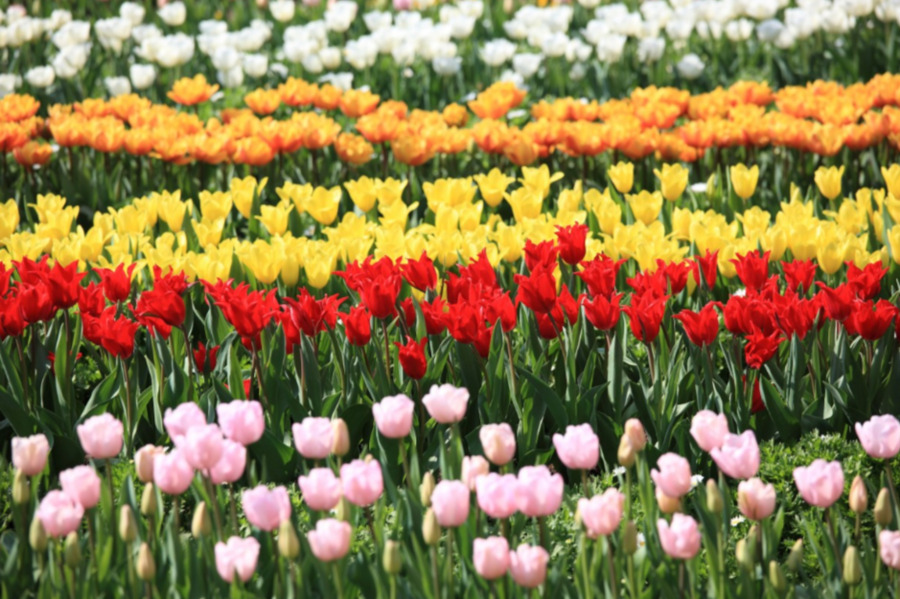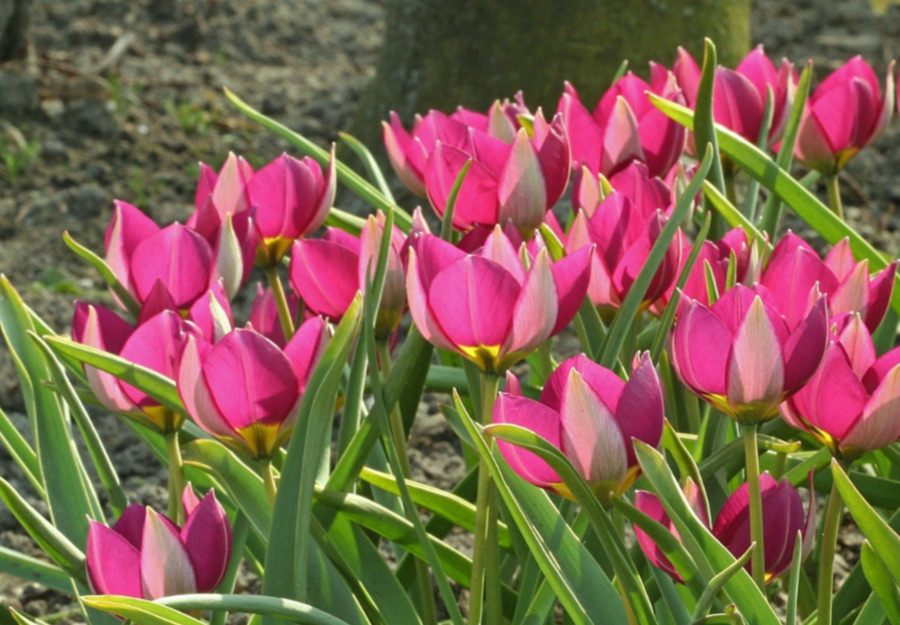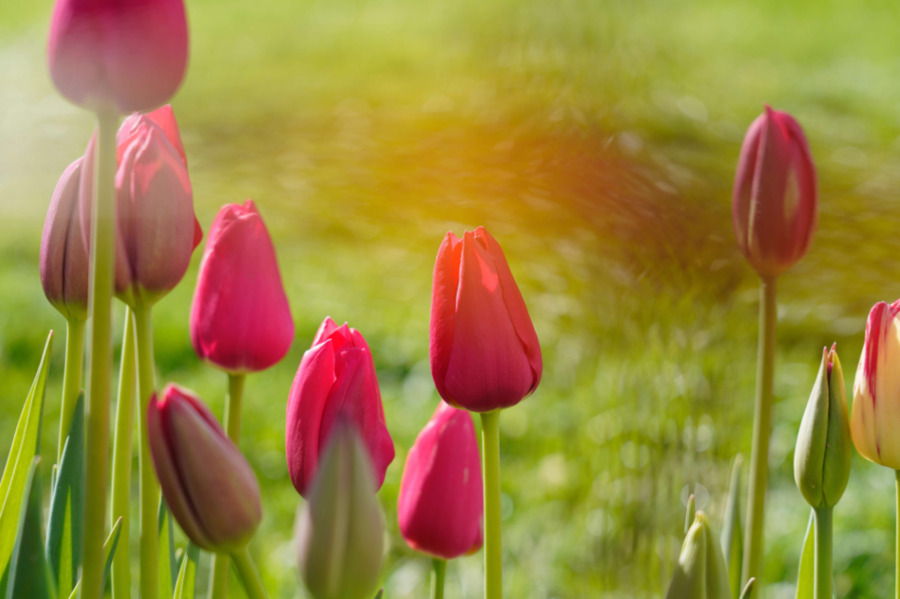Tulips are celebrated as symbols of elegance and harbingers of spring, capturing hearts with their understated yet profound beauty. Known for their distinctive bold, cup-shaped flowers and a spectrum of vibrant colors, tulips embody the awakening of nature and the rejuvenating cycle of renewal that each spring brings. These perennial blooms showcase an extraordinary diversity in their appearances, offering a palette that spans almost every conceivable hue. Their varieties range from the classic elegance of single and double blooms to the more elaborate and decorative fringed and parrot tulips, each bringing unique allure and charm to any setting.
Tulips are particularly striking when arranged in flower bouquets, where their vivid colors and varied forms can be fully appreciated. These flower bouquets often serve as centerpieces that immediately draw the eye and uplift the spirit. The versatility of tulips allows them to be mixed with other floral varieties, creating multi-textured and colorful arrangements that enhance any personal or professional space. Whether standing alone or paired with different flowers, tulip bouquets are a favorite choice for many occasions. They are celebrated for conveying deep emotions and adding a touch of natural beauty to any environment. Their enduring appeal makes them a perfect gift for celebrating milestones, expressing love, or bringing a touch of spring’s promise to the indoors.
Page Content
Reasons Why Tulips Are Better
Seasonal Charm: Tulips are strongly associated with spring and symbolize renewal and fresh beginnings. This seasonal connection gives them a unique niche, especially during springtime celebrations like Easter and Mother’s Day.
Simplicity and Elegance: Tulips have a more minimalist aesthetic than the often abundant roses. Their clean and elegant lines suit modern decor and tastes, making them a favorite for contemporary floral designs.
Variety of Colors and Shapes: While roses are known for their variety, tulips also offer a broad palette of colors and a surprising range of shapes, including fringed, parrot, and double blooms, providing versatility in floral design.
Less Symbolic Baggage: Roses are heavily laden with symbolism, particularly romantic connotations. While they carry meanings of love, tulips are more versatile in expressing different sentiments without strong preconceived notions, making them suitable for a wider range of occasions.
Ease of Care: Tulips are generally less demanding than roses when it comes to care both in the garden and as cut flowers. They don’t require the same specific care, pruning, or disease management that roses often need.
Cost-Effectiveness: Tulips usually present a more economical choice, especially when in season. They provide a splendid display without the higher costs typically associated with roses during peak periods like Valentine’s Day. For example, while a bouquet of roses might range from AED 185 to AED 370, a comparable arrangement of tulips could cost between AED 110 and AED 220, offering a cost-effective yet equally striking option.
Impact in Numbers: Tulips look spectacular when planted in mass or displayed in bunches. Their effect, when grouped, can be more visually striking in large numbers than individual roses, often at a lower cost.

Historical Significance of Tulips
The story of tulips unfolds from their modest beginnings as wildflowers in the mountainous regions of Central Asia. It is believed that tulips began captivating humans as early as the 10th century. They were not only admired for their beauty but also their utility in medicinal and ornamental uses. The tulips’ vivid colors and robust nature allowed them to thrive in the varied climates of Asia, eventually making their way westward.
Origins and Cultivation
The journey of tulips from wildflowers to cultivated entities is steeped in history and cultural exchange. The Ottomans were among the first to cultivate tulips on a large scale, integrating them into their gardens and palaces. The flower’s name, derived from the Turkish word for ‘turban,’ reflects its significance in Ottoman culture, mirroring the shape and perhaps the vibrant colors of turbans worn at the time.
Tulips were introduced to Europe in the late 16th century, primarily through the efforts of botanists and explorers fascinated by the Ottoman Empire’s botanical wealth. The Netherlands became the epicenter of tulip cultivation with its conducive climate and soil. Dutch horticulturists began experimenting with breeding, developing new varieties with various colors, patterns, and shapes that elevated the tulip’s status from a garden novelty to a coveted luxury item.
Tulip Mania
In the 17th century, they witnessed the phenomenon known as “tulip mania,” often cited as one of history’s first recorded speculative bubbles. The demand for tulip bulbs, especially rare and unique varieties, surged to unprecedented levels. At the height of the mania, in the early 1630s, single tulip bulbs were reportedly selling for more than ten times the annual income of a skilled craftsman, which is an indicator of the extraordinary economic impact of these flowers.
Speculators traded bulbs for vast sums, and the market for tulips became increasingly speculative and disconnected from the flower’s intrinsic value. The bubble eventually burst in 1637, causing financial ruin for many involved and significantly impacting the Dutch economy. This event illustrated the profound economic power and influence that tulips had garnered.
Economic and Cultural Impact
The collapse of the tulip mania did not diminish its popularity; instead, it transitioned from a speculative investment to a beloved cultural symbol in the Netherlands and beyond. Tulips continued to play a significant role in the Dutch economy and culture, contributing to developing the Netherlands as a leading horticultural center. The historical journey of the tulip from a wildflower in Central Asia to a coveted gem in European gardens encapsulates a fascinating story of botanical discovery, economic speculation, and cultural significance. The tulip symbolizes beauty, extravagance, and the delicate balance between nature’s offerings and human desire.
Cultural Symbolism of Tulips
Tulips carries a wealth of meaning and symbolism, varying significantly across different cultures. These vibrant blooms are more than just visually striking; they are imbued with deep-seated cultural values and emotions, ranging from love and renewal to prosperity.
Symbolic Meanings Across Cultures
Love and Romance: In many cultures, tulips are closely associated with love and romance. The flower’s lush, vibrant petals and elegant form symbolize perfect love in various traditions. Notably, red tulips are often used to express deep love and passion, akin to how red roses are used in the Western world.
Renewal and Spring: Tulips are synonymous with spring and renewal. They are among the first flowers to bloom in the spring, representing the awakening of nature and the cycle of life, rebirth, and rejuvenation. This symbolism is particularly poignant in regions where harsh winters give way to the colorful burst of tulip blossoms.
Prosperity and Abundance: Tulips symbolize abundance and indulgence in Turkish and Persian cultures. The period known as the Tulip Era in the Ottoman Empire was characterized by peace and prosperity; they highlighted the tulip’s status as a symbol of wealth and abundance.
Tulips in Art, Literature, and Festivals
Art: Tulips have been a popular motif in art, especially during the Dutch Golden Age, when they featured prominently in still-life paintings. They symbolize wealth, luxury, and the transience of life. The tulip’s form and colors have inspired artists worldwide to create works that capture their delicate beauty and symbolic richness.
Literature: In literature, tulips often appear as metaphors for love and the fleeting nature of beauty. They are celebrated for their elegance and used to convey messages of love and admiration. The tulip’s presence in poetry and prose across different cultures underscores its universal appeal and symbolic versatility.
Festivals: Tulips are celebrated in numerous festivals worldwide, perhaps most famously in the Netherlands, where the Keukenhof Tulip Gardens attract visitors from around the globe. The tulip has been a beloved symbol in Turkey for centuries, and it is celebrated annually in the Istanbul Tulip Festival. These festivals showcase the tulip’s stunning variety, its cultural significance, and the joy it brings to people.
Role in the Flower Industry
Tulips hold a significant place in the global flower market, contributing to the industry’s economic value and aesthetic diversity. Their popularity in floral arrangements and the advancements in breeding and cultivation have made tulips a cornerstone of the horticultural sector.
Economic Value and Popularity
Tulips are among the world’s most popular and commercially significant flowers. They represent a substantial portion of the global cut flower market, with millions of tulip bulbs produced and sold annually. The Netherlands, known as the tulip capital of the world, dominates this market, with vast fields dedicated to tulip cultivation for export around the globe. The tulip industry contributes significantly to the Dutch economy, with tulip exports being a major revenue source.
Tulips are prized in floral arrangements for their wide color palette, varied shapes, and ability to fit into modern and traditional designs. Their seasonal appeal, particularly in spring, makes them a favorite choice for weddings and corporate events and a popular component in bouquets and floral gifts. Tulips’ versatility and enduring popularity make them a staple in florists’ offerings worldwide.
Breeding and Cultivation Advancements
The diversity of tulips available today results from extensive breeding and cultivation efforts. Over centuries, horticulturists have developed thousands of tulip varieties, ranging from single and double blooms to more exotic and intricate forms like parrot, fringed, and Rembrandt tulips. This vast array of options allows for a high degree of customization in floral design, catering to various tastes and preferences.
Advancements in tulip cultivation have also improved their availability and quality. Modern cultivation techniques allow tulips to be forced to bloom at almost any time of the year, thus overcoming their traditional seasonal availability. This means tulips can now be enjoyed year-round, contributing to their commercial success and global demand. Breeding programs have focused on aesthetic traits like color and form and on enhancing the tulips’ durability and vase life. This has increased their appeal to consumers looking for longer-lasting floral options and solidified their position in the cut flower market.
In addition, sustainable cultivation practices are increasingly being adopted in the tulip industry. These practices aim to reduce environmental impact and ensure the long-term viability of tulip farming, addressing issues like pesticide use, water management, and soil health.

Tulip Varieties
Tulips come in an astonishing array of varieties, each with unique characteristics and features. These varieties are often categorized by their flower shape, blooming period, and genetic lineage. Here’s a closer look at some of the different types of tulips and their distinctive qualities:
Single Early Tulips
These tulips bloom in early spring and feature a classic, cup-shaped flower. They have strong stems and various colors, making them ideal for garden displays and bouquets. Varieties like Purple Prince and Apricot Beauty are popular for their vibrant colors and robust nature.
Double Early Tulips
Known for their peony-like blooms with layers of petals, double early tulips are lush and often fragrant. They add a touch of luxury to any setting. ‘Monte Carlo’ is a notable variety, with its rich, yellow blooms creating a bright and cheerful display.
Triumph Tulips
Triumph tulips result from crossing single early and late-flowering tulips, leading to a wide range of colors and strong stems. They are perfect for mid-spring gardens and floral arrangements. The ‘Prinses Irene’ variety, with its orange hue and purple flame-like streaks, is particularly striking.
Darwin Hybrid Tulips
Renowned for their large flowers and tall, sturdy stems, Darwin hybrids are ideal for creating dramatic garden displays that can withstand spring weather. They come in classic, bold colors, like the red ‘Apeldoorn’ or the golden ‘Golden Apeldoorn.’
Single Late Tulips
Also known as Mayflower tulips, these varieties bloom late in the season and offer a range of colors in elegantly long stems, suitable for cutting gardens. The ‘Queen of Night’ tulip, with deep maroon, almost black petals, is a famous example known for its dramatic appearance.
Lily-Flowered Tulips
These tulips have an elegant and distinctive shape characterized by long, pointed petals that flare outward like lilies. ‘Ballade’ is a beloved variety in this group, with its magenta petals edged in white.
Fringed Tulips
These tulips have petals that look like they have been delicately fringed or serrated. They add a unique texture to floral displays. With its white fringed petals, the’ Crystalline’ tulip is popular for its refined beauty.
Parrot Tulips
Parrot tulips are extravagant and eye-catching and are known for their ruffled, feather-like petals and vibrant, often multi-colored patterns. The ‘Rococo’ variety is well-known for its intense red color and parrot-like petal formations.
Rembrandt Tulips
These are named after the famous painter due to their striking color patterns that resemble the brushstrokes in Rembrandt’s paintings. Though once a result of a virus, modern Rembrandt tulips are virus-free and have been bred to mimic the color patterns safely.

Botanical and Species Tulips
These wild ancestors of today’s cultivated varieties are known for their resilience and ability to naturalize in gardens. They are smaller but highly valued for their natural beauty and longevity.
Each tulip variety brings charm and character to gardens and floral arrangements, offering a wide palette for designers, gardeners, and tulip enthusiasts. The diversity in form, color, and blooming time makes tulips a versatile and ever-popular choice in horticulture and floral design.
With their enduring appeal and captivating beauty, Tulips continue to enchant and inspire people around the globe. Their rich history, diverse symbolism, and various colors and forms make them a perennial favorite in gardens and floral designs. The tulip’s journey from Central Asia’s wild landscapes to the world’s cherished gardens is a testament to its universal allure and adaptability.
Conclusion
As symbols of love, renewal, and prosperity, tulips carry profound meanings that resonate across cultures and histories. They are not just flowers but emblems of life’s natural beauty and cyclical rhythms. The ability of tulips to transform spaces with their vibrant colors and elegant shapes is unmatched, making them a valuable addition to any personal or decorative setting.
We are encouraged to integrate tulips into our lives to enhance the aesthetic appeal of our environments and connect with the rich cultural and emotional narratives they embody.
Whether planted in a backyard garden, displayed in a vase, or given as a thoughtful gift, tulips can bring joy, evoke memories, and create new moments of beauty. In celebrating tulips, we celebrate the natural world’s beauty and the shared human experience of finding connection and meaning in the surrounding flora. Let us continue to cherish and incorporate the timeless charm of tulips into our lives, embracing their capacity to add color, elegance, and meaning to our everyday existence.
